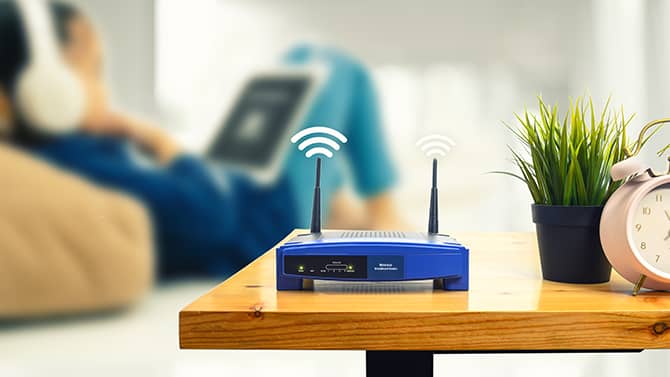In today’s connected world, a secure home Wi-Fi network is as important as locking your front door. If your Wi-Fi network has a weak or unsecured signal, cybercriminals and people who shouldn’t be home can gain access to your personal data, electronic devices, and smart gadgets. Fortunately, creating a secure Wi-Fi network isn’t difficult or time-consuming. With a few simple steps, you can prevent others from accessing your home network without your permission. Then, you can surf the web, watch streaming media, or work online without worrying about security.
Choose a reliable router
The router serves as the primary security measure for your Wi-Fi network. By purchasing a new, high-quality router, you’ll benefit from faster speeds, more features, and the latest security measures. If you want a router that supports the latest Wi-Fi standards, such as Wi-Fi 6 or Wi-Fi 5, make sure it supports WPA3 or WPA2 security protocols. These routers often come with filters and software updates that protect them from new threats. Avoid using an outdated router that might have security problems or lack software updates.
You can change the administrator username and password
After you set up your router, you should first change the general user password. Many routers come with default usernames and passwords, such as “admin” and “password,” that are easy for hackers to crack. Changing the name to something unique and secure reduces the risk of someone accessing your router’s settings without your permission. Choose a strong administrator password that contains letters, numbers, and special characters, and keep it in a safe place.
Changing the network name
When people search for a Wi-Fi network to connect to, the service set identifier (SSID) appears as the network name. Many routers have names such as “TP-Link1234” or “NetgearHome,” which indicate the make or model. These names can provide hackers more information about your router and make it easier for them to exploit known vulnerabilities. Instead of including your name, address, or other identifiable information in the SSID, opt for a unique password that is not personal.
Set a strong Wi-Fi password
To keep your network secure, you need a strong Wi-Fi password. Don’t use familiar passwords like “12345678,” “password,” or your pet’s name. Instead, use a password that is at least 12 characters long and includes numbers, special characters, uppercase and lowercase letters, and more. Something more unique, like “SunnyDogs@Park2025,” is a good idea because it’s easy to remember but difficult to crack. All devices connected to your network should use this password and change it regularly.
Set up network encryption
Nowadays, routers come with security measures to ensure that the data you send over the network is safe. Always use the strongest encryption settings you can find. Currently, WPA3 is the most secure option, but you can also use WPA2 if your router doesn’t support it. Hackers can bypass older standards like WEP in minutes, so don’t use them. Encryption settings are usually located under “Wireless” or “Security” on your router’s screen.
Update your router’s firmware
Firmware updates can fix bugs, make your device run faster, and close security holes. Your router, like your computer or phone, needs to be updated regularly. Check your router manufacturer’s website or control panel for changes. Some newer routers can update themselves, but many still require manual setup. Set it to check for changes at least every few months, or set it to update automatically if your computer allows it.
Stop remote management
You can change your router’s settings from outside your home network using remote management. This feature is convenient, but it can also be a security risk. If you don’t need online access, it’s best to disable it completely. On most routers, this feature is located in the interface under “Remote Management,” “WAN Access,” or a similar setting. If you disable this setting, hackers from outside your network will not be able to take over your router.
Logging in to a guest network
Guests can use your internet connection if you have a guest network, but they can’t access your main network or its devices. This feature is often used if your primary Wi-Fi network is used by a smart home system. Keep WPS enabled. Disabling WPS in your router settings can make it harder for hackers to break in.
Monitor connected devices
Knowing which devices are connected to your network can help you spot unusual behavior. Most routers have a list of all currently connected devices in the admin panel. Please review this list regularly to ensure you are familiar with the details of each device. If you observe any unusual connections, please change your Wi-Fi password promptly and consider blocking access until you have the opportunity to investigate further.
Ensure firewall and anti-virus protection
Many routers often have built-in firewalls. Firewalls can prevent outsiders from accessing your network. Please ensure that your firewall is enabled. Also protect your personal devices with security software to block malware, phishing attacks, and fake access points. Your home network is protected on multiple levels, including router-level and device-level security.
Hide your network (optional)
To better protect your privacy, you can hide your Wi-Fi SSID so that it doesn’t show up when someone searches for open networks. This won’t prevent a real hacker from finding your network, but it will reduce the chances of an average user trying to connect. If you hide your network, every device that wants to connect will have to manually enter the SSID and password.
Educate your family
Securing your Wi-Fi is a team effort. Make sure your family knows the importance of keeping passwords secret, avoiding suspicious links, and reporting unusual network activity. Teach your children and family members not to share their Wi-Fi passwords, and explain the risks of connecting to unknown devices or networks.
A smart setup is the first step to security
Setting up a secure Wi-Fi network at home may seem daunting, but it’s not if you break it down into steps. You can secure your home network by choosing a powerful router, keeping your settings up to date, setting a strong password, and being aware of potential threats. With a little attention, you can protect your data, devices, and family from common cyber threats. You can also give your family the secure and stable internet connection they deserve.
Frequently Asked Questions (FAQ)
Question 1: How often should I change my Wi-Fi password?
It is advisable to change your Wi-Fi password every 3 to 6 months and immediately if you suspect unauthorized access. Also update your Wi-Fi password if you share it with many guests or third parties.
Question 2: What type of encryption is best for my Wi-Fi network?
WPA3 is currently the most secure encryption standard. If your router does not support WPA3, WPA2 is the best choice. Avoid WEP, as it is outdated and vulnerable to hackers.
Question 3: Should I hide my SSID?
Hiding the SSID adds a layer of obscurity but does not significantly increase security. Strong passwords and encryption are more effective. Experienced attackers can still detect hidden networks.
Question 4: Does a password-protected Wi-Fi network still leave me vulnerable to hacking? Indeed, this is possible if your password is weak or if your router has outdated firmware or encryption. That’s why it’s crucial to use strong passwords, keep your router up to date, and disable unsafe features like WPS.
Q5: What should I do if I find an unknown device on my network?
Immediately change your Wi-Fi password and reboot your router. You can also block unknown devices from your router’s admin panel and enable MAC address filtering for added security.
Q6: Do I need to install antivirus software if my router has a firewall?
Yes, a router firewall helps, but it’s not a replacement for antivirus software on a single device. Together, they provide a multi-layered defense against malware, phishing, and other cyber threats.
Q7: What is a guest network? Why use one?
A guest network provides internet access to guests but doesn’t allow them to interact with your most important devices. It keeps your devices safer by isolating smart home devices, computers, and personal files from unknown users.
Q8: Is it safe to use the same router for years?
This is safe as long as the manufacturer continues to support it through firmware updates. If your router is older than 4–5 years old and no longer receives updates, it is time to consider upgrading for better security and performance.



